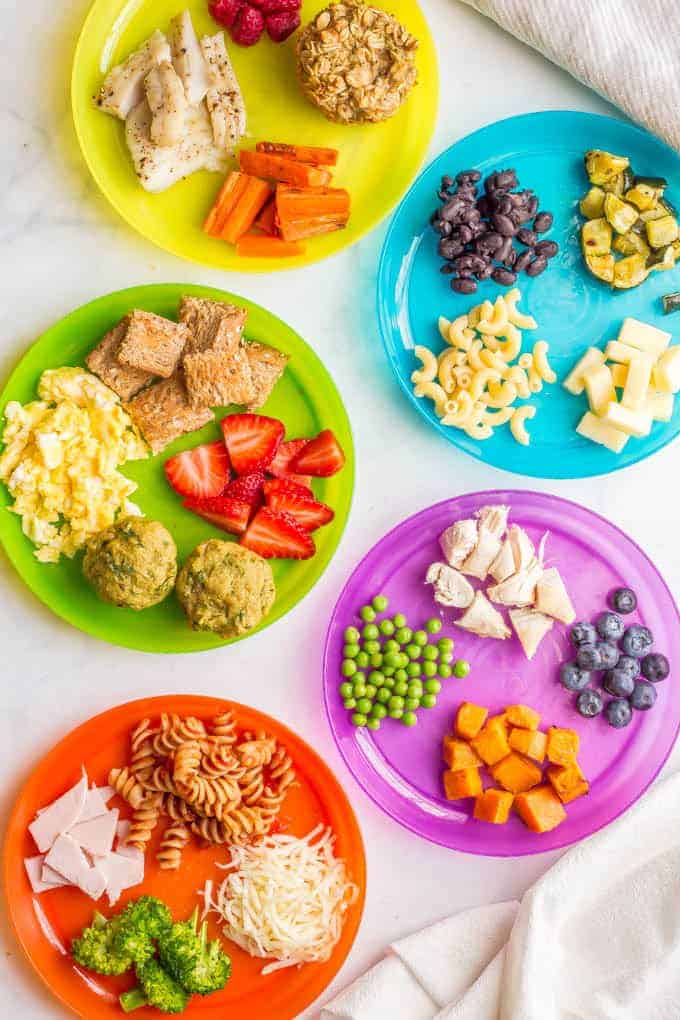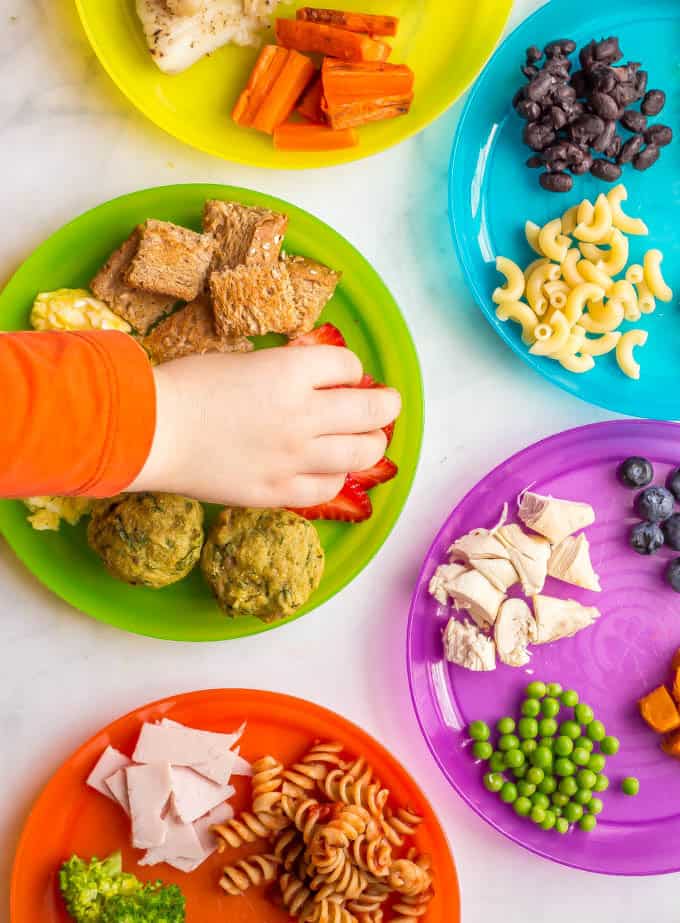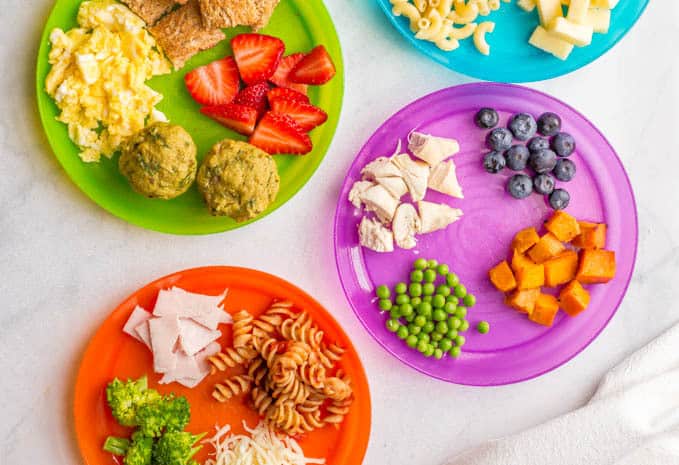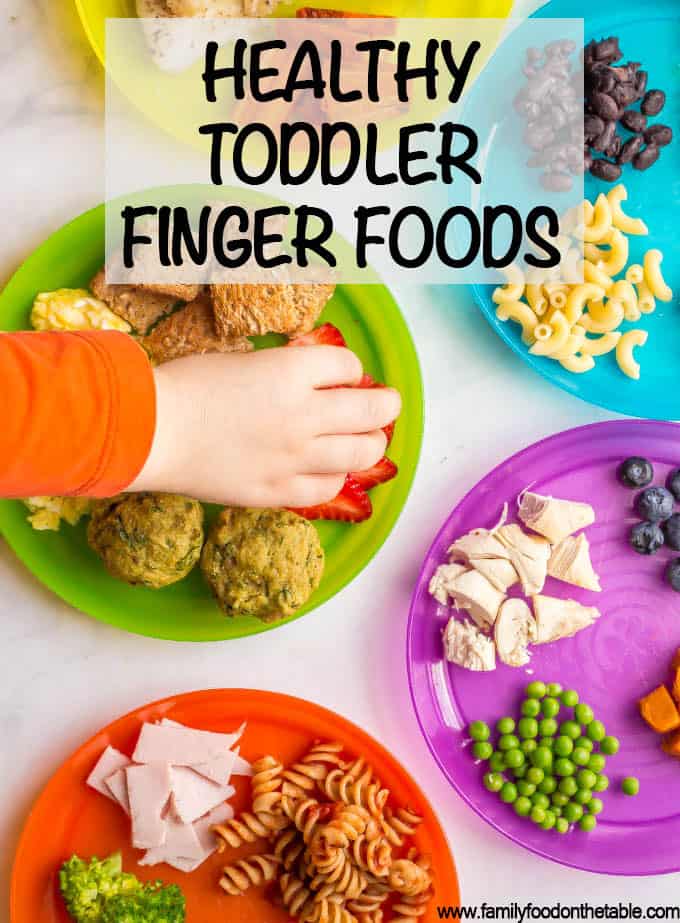Today it’s ALL about healthy baby finger foods and toddler finger foods. I’m going to break things down and try to answer ALL your questions about this fun transition. (If you are looking for healthy toddler finger food ideas to serve, rather than general information, I’ve created a list of healthy toddler finger food ideas, organized by category. And a free printable too!) Watching your baby or toddler start to feed themselves, seeing that joy and pride as they are able to do it themselves, it’s an important milestone. It can also be stressful though. Knowing what’s OK to feed your child, what’s not OK, and how to offer foods can be intimidating. And I’m just gonna say, it’s scary when they occasionally gag on a food. It will happen - it’s totally normal and part of the process (and gagging is not the same as choking). I also found meal-time became much more time-consuming when my kids were feeding themselves. And much messier. (If you don’t have a dog, I’d suggest you get one. Soon. )
So don’t feel bad if you occasionally get frustrated with how long it takes your child to feed themselves or with how inept they can be at the beginning! Or how fun they think it is to throw their food. It gets better. Hang in there. Let’s dive in.
Common questions about healthy baby finger foods and toddler finger foods
What are finger foods?
Finger foods are small pieces of soft food that a baby can pick up and feed itself. Examples of common first finger foods are small pieces of cooked, soft sweet potato, pieces of ripe banana, strips of ripe avocado, thin soft cheese sticks or cubes and O-shaped cereal.
When should I introduce finger foods to my baby?
Babies can begin solids around 6 months of age. Some families will choose to use baby food purees (I did with my homemade baby food) and others will opt for baby-led weaning, or a combination of both. Regardless, babies can begin practicing picking up some of their own food at 6 months and many will start by 8 months. By about 9 months of age, they will have the fine motor skills to better grasp and pick up their own food. A baby learning to feed itself needs practice! It will be slow at first and they may struggle, but it’s important to let them keep trying without rushing the meal or jumping in to help every time. They’ll improve faster and also enjoy the confidence and independence that comes with self-feeding. As always, consult your pediatrician with questions about feeding your child.
How do you serve baby and toddler finger foods?
Make sure each piece is bite size for your child. For some foods, cutting them into thin sticks will help them grasp it and get it to their mouths to take bites of (especially for children under 9 months old who may not have developed the pincer grasp yet). Make sure foods are soft and able to be gummed or mushed easily. Veggies and pasta should be well-cooked so that they are soft enough. (Some harder foods like O cereal are flaky and will melt in the mouth, so they’re OK too.) Young babies who have trouble with slippery foods might benefit from a little “dusting.” You can crush up some O cereal and roll the slippery food in it to help them be able to grip it better. And then, just pile a variety of foods onto your baby’s plate or high-chair tray and see what they sample!
What baby finger foods and toddler finger foods are safe?
A large variety of finger foods are OK for babies and toddlers to eat. The key is to make sure the size is appropriate and that the food can be gummed easily in their mouths. This is especially true for babies who have few or no teeth and for beginning eaters. (Here’s my list of finger foods with some specifics in each of the food groups!)
What foods are not OK to serve a baby or toddler?
Here’s a list of foods that are not safe for babies and toddlers to eat because they can pose a choking hazard:
Hot dogs Popcorn Whole grapes or whole cherry tomatoes (cut in quarters) Chunks of peanut butter (it’s OK to spread on toast but don’t give clumps of peanut butter) Nuts, including peanuts Seeds, such as pumpkin seeds Raisins and hard dried fruits Raw cherries with pits Hard candies, including jelly beans Marshmallows Gum
How much food should I feed my baby?
The answer here depends on the age of the child. Food for babies under age 1 is “just for fun,” as my pediatrician told us. Before age 1, babies are getting all of the nutrition they need from breast milk or formula, so food is just a bonus for them to be exposed to new flavors and textures and develop some healthy eating habits. So if your baby doesn’t want or eat much, don’t fret. Just keep offering small amounts to let them practice and adjust to feeding themselves. I happened to have BIG eaters with both of my children and I would offer several foods at each “meal” of their day. I started with just a couple of tablespoons of each food — I didn’t want to waste it if they were only going to have a small bite — and then moved up to about ¼ cup of each food as they wanted more. Check out this sample menu for a one-year-old from the American Academy of Pediatrics.
How much food should I feed my toddler?
Toddlers need between 1,000 and 1,400 calories a day. It varies a little depending on their age, size and activity level (though pretty much every toddler is very active!) These calories should come from healthy foods in every category: protein, grains, fruits, vegetables, some healthy fats, and milk and dairy. Toddlers should be eating 3 meals a day and 1-2 snacks per day. The daily serving recommendations for 12- to 24-month-olds are about 3 servings of grains (preferably whole grains), 1 serving of fruit, 1 serving of vegetables, 2 servings or protein and 2 servings of milk/dairy. For a child that’s between 2 and 3 years old, the servings increase slightly to 5 servings of grains, 1 ½ servings of fruit, 1 ½ servings of vegetables, 2-4 servings or protein and 2 servings of milk/dairy. Check out this sample menu for a two-year-old from the American Academy of Pediatrics.
Finally, 7 tips for introducing finger foods:
There you go my friends! All about baby and toddler finger foods and the fun journey that begins when your child gains that bit of independence and control. And don’t forget to check out my list of healthy toddler finger food ideas! Also, in case your little one struggles with teething - don’t they all? - check out these homemade teething biscuits. They store great in the freezer, too. It’s got tons of fruits, veggies, grains, proteins and dairy choices you can offer your little one and a free printable that you can have on hand so you don’t get stuck in a rut with the same foods. Finally, please let me know in the comments below if you have other questions - I’m happy to help! XO, Kathryn



